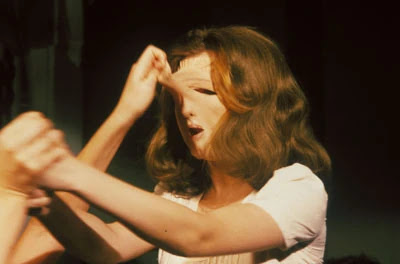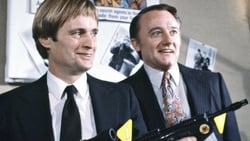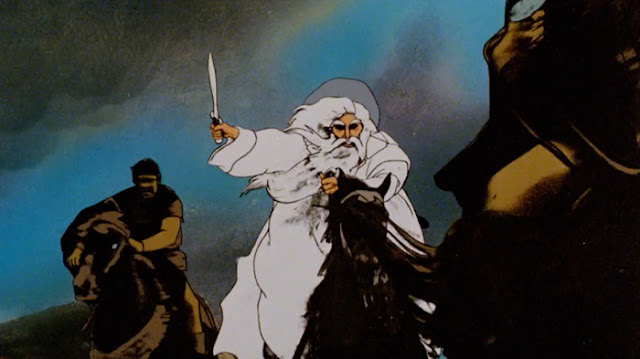PHENOMENALITY: *marvelous*
MYTHICITY: *fair*
FRYEAN MYTHOS: *adventure*
CAMPBELLIAN FUNCTION: *metaphysical, psychological, sociological*
Xena, first featured in a three-part episode of HERCULES THE LEGENDARY JOURNEYS, started her quest to mend her previously destructive ways in her titular series. The first episode teamed the character, played by Lucy Lawless, with her boon companion Gabrielle (Renee O'Connor), who supplied most of the show's comedy relief. The first season is also fairly rough in terms of its symbolic discourse, though several episodes contain myth-kernels that would receive greater development in later seasons. As in previous reviews of TV seasons, I will denote the level of mythicity in each episode with either a P for poor, an F for fair, or a G for good.
SINS OF THE PAST (F)-- For her first good deed, Xena seeks to thwart the plundering of a helpless village by Draco, one of Xena's old warlord-allies and a former lover as well. Draco warns that the people of Xena's home village will reject her due to her past, as indeed they do. The innocent but adventurous Gabrielle petitions to join the warrior princess. Initially Xena refuses, but she's won over by the young girl's pluck. Even though Xena prevents Draco from destroying Xena's home town, the heroine remains largely estranged from her place of birth.
CHARIOTS OF WAR (F)-- The warlord Cygnus wishes to destroy a defenseless farming community, and he complains that his only son Sphaerus isn't up to the task, in comparison to his late son Stentor. Further, when Xena defends the farmers, it's revealed that Cygnus thinks Xena guilty of killing Stentor. This is an OK meditation on the consuming desire for warfare but nothing special.
DREAMWORKER (F)-- Marius, ruthless worshiper of the dream-lord Morpheus, kidnaps Gabrielle to become the god's bride. The priest hurls Gabrielle into a dream-universe, where she will become Morpheus' prize if she makes the mistake of killing anyone in the dream. Xena uses a mystic ritual to follow Gabrielle into the dream-verse and keep her friend from making a fatal error. The script doesn't hold together well, but the concept of Gabrielle's "blood innocence," her freedom from Xena's taint of killing, takes on much greater importance later on.
CRADLE OF HOPE (F)-- King Gregor is warned of a prophecy that he will lose his throne to a fatherless child, so he sends his men looking for that fateful infant. Xena and Gabrielle find and protect the child, and also guard over a woman named Pandora, a descendant of the famous one. This Pandora preserves the original Pandora's Box, and claims that it still holds its one good entity, the spirit of Hope. The two plotlines of Pandora and the baby don't line up well, but the name "Hope" would be given to a major character in a later season.
THE PATH NOT TAKEN (F)-- Arms dealer Mezentius kidnaps a young bride whose marriage would have sealed a treaty between two rival kingdoms. The warlord plans to foment war between the kingdoms and then clean up selling weapons to both sides. Xena pretends to have returned to her evil ways in order to deceive Mezentius and rescue the bride, but this strategy also means deceiving an old ally, Marcus, who then appears again in MORTAL BELOVED.
THE RECKONING (F)-- Gabrielle becomes Xena's lawyer when the warrior princes is falsely accused of murder. The whole thing is a setup by Xena's former mentor, Ares God of War, essayed for the first time by actor Kevin Smith. Ares tries to persuade Xena to return to her warlike ways under his tutelage, but she tricks him and remains her own woman. There's an odd line about how Xena has never seen him in this form before, but she doesn't say what he looked like before. Later episodes will imply that the two might have been lovers as well as teacher and student.
THE TITANS (P)-- Gabrielle accidentally unleashes three of the gigantic Titans of elder times, For a short time they obey Gabrielle, thinking her a goddess. Then rebellious Hyperion exposes her as a mortal, and he lays plans to force Gabrielle to unleash other sleeping Titans on the world. Xena has to pull Gabrielle's hash out of the fire.
PROMETHEUS (G)-- Xena's first crossover in her own series is also her first strong mythic episode. Hercules' perpetual sparring partner, the Goddess Hera, causes the Titan Prometheus to be bound. This action deprives humanity both of Prometheus' gift of fire and, for some unstated reason, the ability to heal wounds. (Did the writers mix up Prometheus with Philoctetes, the Greek soldier with the unhealing wound?) Xena and Gabrielle seek a special sword that can sever the Titan's bonds, but Hercules and his sidekick Iolaus are on the same mission. It's revealed that the person who cuts the Titan's chains will be slain, so naturally each hero competes to make sure he, or she, is the one to nobly sacrifice his or her life. The episode provides Gabrielle's first encounter with Hercules and Iolaus, and Hera appears in the guise of a pair of hovering eyes and a disembodied voice.
DEATH IN CHAINS (G)-- King Sisyphus is destined to die when Celesta, goddess of death and sister to Hades, takes possession of his soul. The selfish mortal traps Celesta in his castle, but this means that no person on Earth can perish naturally. Hades himself sets Xena on Sisyphus' trail, and on the way Gabrielle has what seems to be her first romance with a young man named Tallus.
HOOVES AND HARLOTS (F)-- Xena and Gabrielle pass through the territory of the Amazons, just in time for a new outbreak of hostilities between the tribe of female warriors and the neighboring tribe of Centaurs. There is of course a third party manipulating the two tribes to fight one another. Still, there's a lot of good Amazon action, and Gabrielle becomes an Amazon princess, another story-trope that will be played up later on. She also gets her familiar fighting-staff here.
THE BLACK WOLF (F)-- Xena tries to help a gang of revolutionaries, led by the mysterious Black Wolf, against a tyrannical warlord. The fights are the best thing here, particularly one in which Xena comically humiliates the warlord's second in command. The comedy relief character Salmoneus, who'd been introduced in the same HERCULES episode where Xena debuted, meets Gabrielle for the first time.
BEWARE GREEKS BEARING GIFTS (P)-- This is the first episode to center Xena in a specific period of Greek history, making her contemporaneous with the Trojan War. In due time that specificity would go out the window. Xena and Gabrielle infiltrate Troy in order to render aid to Helen, but they can't stop Troy's fall thanks to a certain horsey gift. One of the Trojan defenders is Perdicas, the suitor Gabrielle left behind in her hometown, but though she's more impressed with him now, she remains committed to her path with Xena. Perdicas departs the fallen city accompanied by Helen, seeking freedom from being a war-prize.
ATHENS CITY ACADEMY OF THE PERFORMING BARDS (P) -- This episode holds a smattering of slightly amusing jokes about Gabrielle attending a Greek version of a "school for the performing arts." But a few laughs can't mask the awfulness of a godawful "clip show." Lucy Lawless barely has any new scenes, but along with clips from Xena-episodes, the producers included a few clips from old Italian peplum-flicks for extra yocks.
A FISTFUL OF DINARS (P)-- A dull treasure-hunt episode, wherein Xena and Gabrielle try to prevent a god-weapon from falling into the hands of rotten treasure-hunters. One of the rapscallions is Petrocles, Xena's ex-fiancee, but the script doesn't play off their animus in any creative way. Petrocles does make a pass at Gabrielle, but this doesn't develop into any meaningful drama either.
WARRIOR... PRINCESS (F)-- Xena has her first meeting with a "Princess Diana" who is Xena's dead ringer, meaning that Lucy Lawless gets the chance to play a double role. Xena masquerades as the helpless royal in order to thwart assassinations and to make possible an advantageous marriage. Good fights and good comic byplay.
MORTAL BELOVED (F)-- One consequence of Xena's good deed in "The Path Not Taken" is that her old friend (lover?) Marcus perishes as collateral damage. Then Marcus' ghost appears before Xena, summoning her to the underworld to sort out a problem. The evil shade Atyminius has stolen the cap of invisibility from Hades, and this somehow empowers him not only to control the destinies of other shades, but to impinge upon the living world as well. This episode is fairly light on battle scenes because it places the most emphasis on the renewed relationship of Xena and Marcus. Lawless get her first real chance to do some strong romantic emoting on the show.
ROYAL COUPLE OF THIEVES (F)-- Another support-character from HERCULES, the thief Autolycus, crosses over into the Xenaverse. The warrior princess drafts the wily burglar into helping her recover, from a thieves' auction, what appears to be the Ark of the Covenant. The McGuffin is pretty unimportant as the episode spotlights the fractious partnership of Xena and Autolycus. Xena shows that she has a talent for the thieving life, and she gets to fight another master of her "Greek kung fu." Gabrielle barely appears, but the true owners of the ark seem to be itinerant Jews, though this is never stated outright.
THE PRODIGAL (P)-- Gabrielle becomes the prodigal daughter to her home village, as she returns there to re-evaluate the adventuring life. Her sister Lila resents Gabrielle for running off, but the greater threat is a troop of marauders. The village has hired a protector, the famed Meleager (Tim Thomerson), but he's a drunk who's lost his nerve. (CAT BALLOU anyone?) Xena only appears in scenes at the start and the closing. And what's with the concept of road-thieves who run down their victims with a wagonload of logs?
ALTARED STATES (G)-- If ROYAL COUPLE was over-respectful toward some sort of proto-Jews, ALTARED assails the dangers of unquestioning faith with a reworking of the Old Testament story of Isaac's near-sacrifice. Xena and Gabrielle interfere when a 12-year-old boy Icus is marked for sacrifice by the worshipers of his tribe, led by Mael. Icus's older brother. (The names Icus and Mael are altered versions of Isaac and his brother Ishmael.) The father of both boys, Anteus, is the stand-in for the Biblical Abraham. Anteus sincerely believes that his unnamed God has ordered Icus' altar-sacrifice, but Xena and Gabrielle eventually learn that Mael has faked Anteus' messages from God. Mael wants his brother dead because Anteus was going to promote Icus above Mael. An odd subplot is that these quasi-Jews have had their will sapped by eating a type of bread accidentally laced with the hallucinogen henbane. This has nothing to do with Mael's plot, since one source of the bread is Anteus' estranged wife Zora, who's returned to her pagan faith in opposition to the sacrificial ritual. The bread may have little to do with the main plot but it does give a dosed Gabrielle some funny scenes. Mael, in addition to attempting indirect fratricide, is also hostile to the ideal of powerful women, giving a speech about Xena being an affront to normal male-female roles. This may have been a small shot at evangelical Christians of the nineties, but the script keeps things from being preachy by emphasizing the tortured faith of Anteus, and a force that intervenes to prevent the sacrifice.
THE TIES THAT BIND (F)-- While Xena and Gabrielle seek to free a contingent of slaves from the dealer Kirilus, they encounter Atrius, an older man who claims to be Xena's father, who left Xena and her mother during the former's childhood. While this is going on, Kirilus, who worships Ares, is visited by the war-god, who manipulates the mortal into pressing an attack against Xena. After a lot of time-killing incidents, it's revealed that Atrius is actually Ares in disguise, attempting to lure the warrior princess back into his service. The episode is interesting given a later plotline that could have revealed Ares to be Xena's real father, though this idea was reworked into the third-season episode THE FURIES. TIES is notable for being the first time Gabrielle ever strikes Xena, albeit with the aim of bringing her to her senses.
THE GREATER GOOD (F)-- The best aspects of this episode got played down in the final cut, with Gabrielle trying to come to a separate peace with Xena's horse Argo. Xena, while trying to rescue guest-star Salmoneus from the warlord Talamedeus, gets hit with a slow poison. It almost incapacitates her, but she's able to school Gabrielle in the fine art of impersonating a warrior princess. The deception doesn't keep the warlord at bay for very long, though, and Xena appears to perish of the poison, causing both Gabrielle and Salmoneus to mourn. However, Xena recovers for some reason and kicks the bad guys' asses.
CALLISTO (G)-- Ares appeared far more often in the XENA series, but Callisto (Hudson Leick) remains the princess' most mythic foe. She technically made an "appearance" in GREATER GOOD, as she was the unseen assailant who hit Xena with a poison dart. But in this episode, Callisto challenges the heroine not only physically, but also morally, by claiming to be a survivor of one of Xena's past misdeeds. While Xena mordantly ponders the fruits of her past evils, Gabrielle has a considerably more humorous encounter with another new support-character, would-be warrior Joxer (Ted Raimi). The episode's climax is the season's most impressive set-piece, with Xena fighting Callisto and her men atop a huge fortification while Gabrielle is held by a rope that will burn through any moment. But a far more insidious indicator of Callisto's Satanic nature appears when she orders the soft-hearted Joxer to act the part of a warrior he thinks he is, and simply cut Gabrielle's throat.
DEATH MASK (F)-- Another family reunion episode for Xena. It had been established that Xena became a warrior princess to avenge her younger brother Lyceus, but for the first time she gets a chance to take down the man who led the marauders, the warlord Cortese. When Xena and Gabrielle are attacked on the road by masked bandits, Xena recognizes the masks as the kind worn by Cortese and some of his commanders. A little later, Xena meets another masked man, but this time it's her older brother Toris (never mentioned before and never seen again). Toris has infiltrated Cortese's troops as a strategy to get close enough to kill him, though Xena hopes for justice rather than vengeance. Xena also thinks that Cortese is working with a spy in the service of the local monarch-- only to learn that Cortese himself had become that monarch, and is using the bandits to plunder his people (which is the only reason he now wears the mask while in battle). Toris' rash desire for vengeance makes him a captive of the raiders, and Xena must rescue him. Toris' "survivor guilt" character arc is underwhelming. Cortese, having been established as the mortal who caused Xena's corruption, loses all mythic stature when he's reduced to the level of a double-identity schemer.
IS THERE A DOCTOR IN THE HOUSE? (F)-- Xena and Gabrielle seek to end a civil war between the Mitoans and the Thessalians, and in the process they come across the Amazon Ephiny, last seen in HOOVES AND HARLOTS. Ephiny is now pregnant by her centaur husband, who was slain during one of the local battles, so Gabrielle takes the Amazon to the local Temple of Ascelapius for further care-- the same temple where many of the war-wounded turn up. Xena captures Mitoan general Marmax and transports him to the same temple so that he can see some of the carnage up close. Xena, who knows a lot about battlefield medicine, butts heads with Ascelepian priest Galen, whose idea of treatment is to have the temple-god bless the injured. DOCTOR is a surprising close to the first season of an adventure-series whose episodes usually focused on all sorts of wild combat and frequent fatalities, for most of the episode's "action" involves desperate attempts to pull injured patients away from the grip of death. Oh, and Xena invents artificial respiration.
















